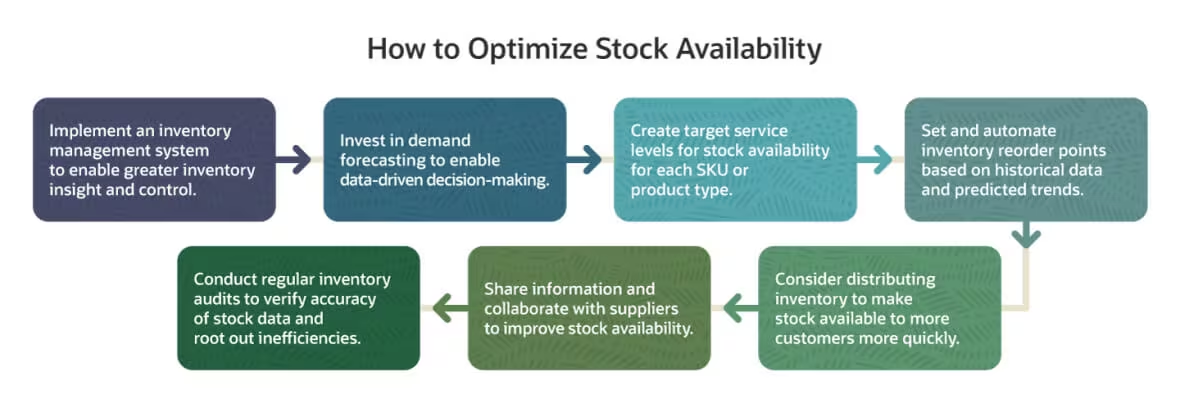In the dynamic realm of e-commerce, the availability of products on the digital shelf stands as a paramount factor in dictating the triumph of any online enterprise. Proficiently handling and sustaining optimal stock levels wields formidable influence over customer contentment, revenue generation, and the overarching prosperity of a business.
This article will delve into the profound significance of digital shelf stock availability for e-commerce ventures, the intrinsic connection between stock availability and customer satisfaction, the substantial repercussions of stockouts on e-commerce revenues, actionable strategies to enhance stock availability, and pivotal performance metrics for meticulously gauging and nurturing stock availability to yield unparalleled results.
Understanding Digital Shelf Stock Availability
Stock availability in the digital realm embodies the lifeblood of e-commerce – it’s the heartbeat of product availability on your online storefront. It encompasses the vitality of your inventory, measuring not just the mere quantity of items in your stockroom but also the precision and immediacy with which your platform broadcasts this vital information to your customers. In the fiercely competitive world of online retail, precise and up-to-the-second stock availability is the linchpin that empowers retailers to exceed customer expectations, shield against inventory droughts, and elevate sales to unprecedented heights.
The Link Between Stock Availability and Customer Satisfaction
Stock availability and customer satisfaction are interlinked. Customers intending to make a purchase require the items to be in stock.
If a product is out of stock or unavailable, it can lead to frustration, disappointment, and even loss of trust in the business.
On the other hand, when customers can easily find and purchase the products they desire, it enhances their overall shopping experience and increases their satisfaction. Happy and satisfied customers are more likely to make repeat purchases, recommend the business to others, and contribute to positive online reviews and word-of-mouth marketing.
The Impact of Stockouts on E-commerce Sales
Stockouts, or situations where a product is out of stock, can have a detrimental impact on e-commerce sales. When a customer encounters a stockout, they have limited options – they can either wait for the product to be restocked, choose an alternative product, or abandon the purchase altogether.
Many customers are time-sensitive and may not be willing to wait for the restocking of a particular product. This can result in missed sales opportunities and potentially lost customers to competitors. Furthermore, forcing customers to settle for an alternative product may not meet their exact needs or preferences, leading to a less satisfactory purchase experience.
Stockouts also have negative consequences for customer loyalty. Customers who encounter frequent stockouts may lose confidence in the e-commerce business, and they may start exploring other options to fulfil their shopping needs. This can significantly impact customer retention rates and overall business growth.
Strategies to Improve Digital Shelf Stock Availability
To improve digital shelf stock availability and minimize stockouts, e-commerce businesses can implement a range of strategies:

1. Inventory management
Establishing streamlined inventory management processes is crucial. This involves accurately forecasting demand, setting appropriate reorder points, and utilizing inventory tracking systems to maintain optimal stock levels.
2. Transparent communication
Clearly communicate stock availability information to customers. Ensure that the e-commerce platform provides real-time updates on stock levels, especially during peak periods or when there are fluctuations in demand.
3. Supplier partnerships
Build strong relationships with suppliers to ensure timely replenishment of stock. Collaborate closely with suppliers to align inventory levels with demand forecasts and minimize the risk of stockouts.
4. Implement safety stock
Maintain a buffer stock, also known as safety stock, to account for unforeseen fluctuations in demand or delays in supply. This helps mitigate the risk of stockouts during peak periods or other unexpected circumstances.
5. Monitor and adjust
Continuously monitor stock levels, demand patterns, and inventory turnover rates. Regularly analyze data to identify trends, make informed decisions, and adjust stock levels accordingly.
Measuring and Monitoring Stock Availability for Optimal Results
To effectively manage stock availability, e-commerce businesses need to measure and monitor relevant metrics. Key metrics to consider include:
- Stockout rate: Measure the percentage of times a product is not available when a customer attempts to purchase it. This metric provides insight into the frequency of stockouts and helps identify areas for improvement.
- Fill rate: Calculate the percentage of customer orders that are completely fulfilled from available stock. A high fill rate indicates robust stock availability, while a low fill rate suggests potential stock management issues.
- Lead time: Measure the time it takes from placing an order with a supplier to the product’s arrival in the warehouse. This metric helps identify any delays in replenishing stock and allows for proactive management of inventory levels.
- Inventory turnover rate: Calculate the number of times inventory is sold and replaced within a specific period. A high inventory turnover rate indicates efficient stock management, while a low rate may suggest excess stock or slow-moving products.
- Customer feedback: Regularly collect and analyze customer feedback regarding stock availability. Keep an eye on customer reviews, ratings, and comments to gain insights into potential stock-related issues and identify areas for improvement.
By regularly monitoring these metrics and taking proactive measures to address any stock availability challenges, businesses can improve their customer experience.
In conclusion, digital shelf stock availability is a critical aspect that can make or break an e-commerce business. It directly influences customer satisfaction, sales performance, and customer loyalty.
E-commerce analytics platforms like 42Signals provide aid in managing inventory levels, understanding out-of-stock products and patterns among other features.
To know more about our product or for a demo, contact us at sales@42signals.com






